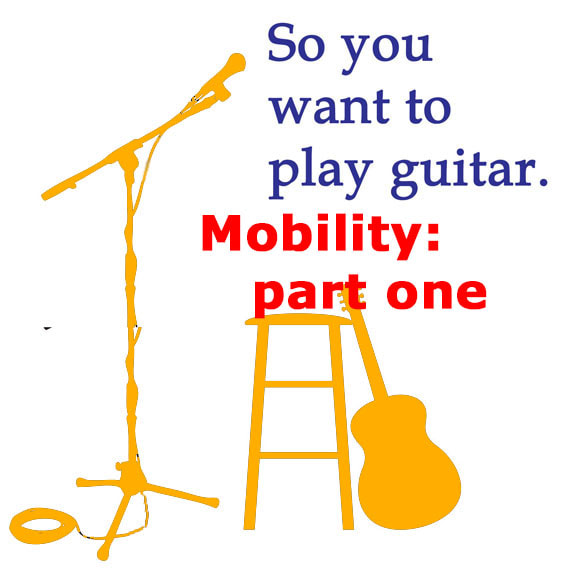OK.
You’re playing guitar.
Sort of.
You’ve got an instrument and know a few chords, preferably the I-IV-V variety.
Stop sitting on the edge of your bed when you practice.
No more sofa time watching streaming media while you run your chords.
If you are physically able to, stand up when you practice.
You’ll need a strap for that guitar because you are probably like me: I don’t have the figure for a strapless guitar. I need that strap.
Why stand when you practice?
Because as a music educator, you want to be able to cruise the room as you play.
You don’t want to be standing in stone forever at the front of the room.
Seriously, if you want to play an accompaniment instrument in your classroom that inhibits your mobility, you might as well play a keyboard.
Using a piano can be a way to create a wall between you and your class.
I knew of a music teacher in a school for kids with severe disabilities who literally pushed an upright piano room to room, every day, every class, simply so she had a buffer, a protective bulwark between herself and the students.
There is nothing quite as enthralling for a music teacher to stand at the front of the class for a few minutes, strumming, singing, and teaching when all of a sudden you take flight and you are striding into the ranks of your class. Suddenly they are next to you, a honest-to-god-living-breathing GUITARIST!
Their eyes will widen and shock will be on their little faces.
And as far as behavior issues, it is the best.
In an instant you can stride up the perpetrator and pronounce, “I can do this standing next to you. I can stand here all class long. I can be your SPECIAL helper. Would you like that? For me to be you SPECIAL helpr for thee next forty minutes??”
It is almost like you are school bus driver with an unruly kid in the back and you suddenly get out of your driver’s seat to address the offender while the bus magically continues driving all by itself.
Spiderman has nothing on you!
So, yes, stand while you practice.
Try not to stare at your hands, too.
And start to stroll as you play.
Your empty classroom before and after the school day is the best place to work on these skills. After all, that’s where you’ll be showing off your new skills to your amazed students.
More on mobility next time!
You’re playing guitar.
Sort of.
You’ve got an instrument and know a few chords, preferably the I-IV-V variety.
Stop sitting on the edge of your bed when you practice.
No more sofa time watching streaming media while you run your chords.
If you are physically able to, stand up when you practice.
You’ll need a strap for that guitar because you are probably like me: I don’t have the figure for a strapless guitar. I need that strap.
Why stand when you practice?
Because as a music educator, you want to be able to cruise the room as you play.
You don’t want to be standing in stone forever at the front of the room.
Seriously, if you want to play an accompaniment instrument in your classroom that inhibits your mobility, you might as well play a keyboard.
Using a piano can be a way to create a wall between you and your class.
I knew of a music teacher in a school for kids with severe disabilities who literally pushed an upright piano room to room, every day, every class, simply so she had a buffer, a protective bulwark between herself and the students.
There is nothing quite as enthralling for a music teacher to stand at the front of the class for a few minutes, strumming, singing, and teaching when all of a sudden you take flight and you are striding into the ranks of your class. Suddenly they are next to you, a honest-to-god-living-breathing GUITARIST!
Their eyes will widen and shock will be on their little faces.
And as far as behavior issues, it is the best.
In an instant you can stride up the perpetrator and pronounce, “I can do this standing next to you. I can stand here all class long. I can be your SPECIAL helper. Would you like that? For me to be you SPECIAL helpr for thee next forty minutes??”
It is almost like you are school bus driver with an unruly kid in the back and you suddenly get out of your driver’s seat to address the offender while the bus magically continues driving all by itself.
Spiderman has nothing on you!
So, yes, stand while you practice.
Try not to stare at your hands, too.
And start to stroll as you play.
Your empty classroom before and after the school day is the best place to work on these skills. After all, that’s where you’ll be showing off your new skills to your amazed students.
More on mobility next time!

 RSS Feed
RSS Feed